Benin
The Kingdom of Benin existed since the 11th century until it was annexed by the British in the 19th century. Benin City was the capital city. Benin was home to the Edo, a people known for their advanced artistic and architectural skills. During a period of economic prosperity in the 13th century, the King Oguola appointed a collective of metalworkers and brass casters who were tasked with creating a large collection of art for his palace and the temples in his kingdom. The sculptures made by this collective are now known as the Benin bronzes. Besides having great decorative value, they also symbolize power and prestige because the commission came from the king himself.
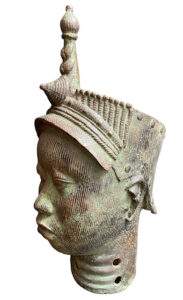
Benin bronze head from the Rootz Gallery Collection.
Representation
Regarding representations, we see several genres.
- History of the Edo with stories of kings and soldiers
You often see in the bronze statues the faces of kings, also called Obas. Among other things, these can be recognized by their crown and beaded necklace. Brave soldiers are also depicted. These can be recognized by their weapons or shields. Depicting soldiers is also a sign of power because the king shows with it how strong his army is and how brave his warriors are.

Bust of an Oba. Benin City, 1960s. From the Rootz Gallery Collection.
- Animals
Within this genre you will most often encounter the lion or leopard. These animals, as with many cultures of the world, are a symbolic representation of courage and royal power for the Edo.
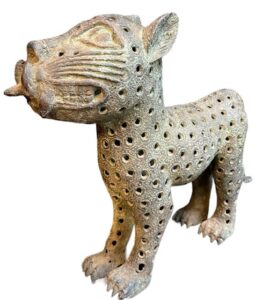
Benin bronze leopard from the Rootz Gallery Collection.
- Mythological figures and gods
Figures such as dwarves and monsters are also sometimes found on bronze statues. In addition, so are gods. These figures come from religious and spiritual stories.
- Daily life
Besides all these heroic and religious depictions, there are also bronze statues showing daily life in the Kingdom of Benin. For example, you will see agriculture or various crafts depicted.
Design
Material
The sculptures are made of bronze or brass. For this, the lost wax method is used. It goes as follows: the model of the sculpture is first made in wax and covered with clay. When the clay is dry, the wax is melted. The bronze or brass is poured into the cavity. When it has cooled and hardened, the clay is removed. This leaves only the bronze or brass. The use of this technique makes sure that no two sculptures are the same.
Size of the figures
A visual hierarchy can be seen in certain bronzes. One often sees this in plaques, which depict multiple figures. The size of these figures can vary considerably, depending on the social status of the figure depicted. For example, kings are usually depicted larger than warriors and warriors, in turn, larger than civilians. This sizing strategy serves to emphasize and symbolize the hierarchical social status of each depicted individual.
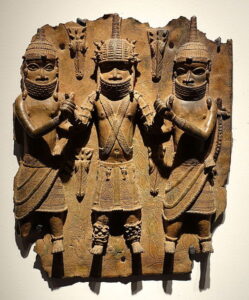
Benin bronze plaque with warriors.
Relief
The plaques are made in relief. This makes the figures appear to come forward.
Details
Vertical stripes can be found on some Benin bronze heads. There is no unambiguous explanation for this. For example, it may represent scarification, but may also have a symbolic meaning such as an indication of status or spiritual power. However, some people believe it is only an aesthetic choice.
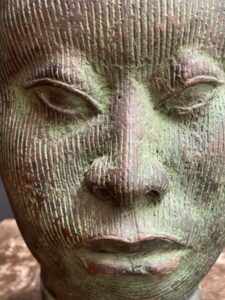
Benin bronze head vertical stripes.
You can also often see a pattern on the coat in the bronze leopards. Here you can see two such examples on the leopards of the Rootz Gallery Collection. In the first image, you can see that the patterns are made on the bronze itself. They are concentric circles, with a kind of grainy texture in between. In the second sculpture, you can see that the patterns are made by circular holes in the bronze. Around them is ring. Between these circles there are still small dents in the bronze.
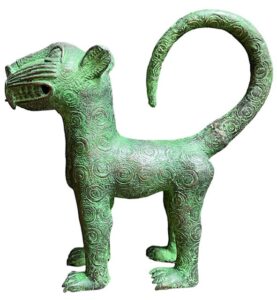
Benin bronze leopard, from the Rootz Gallery Collection.
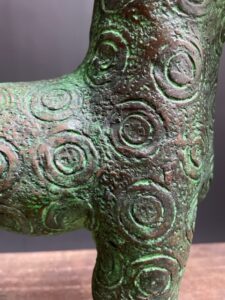
Detail of the leopard. Here you see the concentric circles.
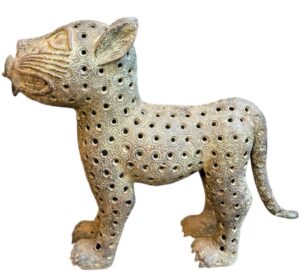
Another Benin bronze leopard from the Rootz Gallery Collection.
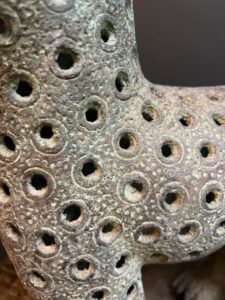
Details of the leopard. Here you see the holes with rings around them.
Eyes
Characteristic of Benin bronzes are the large eyes that are prominently featured in the sculpture. The eye sockets themselves are usually quite deep in the face. They are realistically rendered and sometimes the irises are delicately decorated, drawing your gaze into the sculpture.
Symmetry in composition
What also plays into the often-perceived beauty of the sculptures is symmetry. You can see this in almost all statues. For example, with the animals you see symmetry in the patterning, in the heads of kings you can find facial symmetry, and with the plaques with multiple figures there is often symmetry in the composition. For example, there will be a larger figure in the center and two smaller figures to the left and right of it.
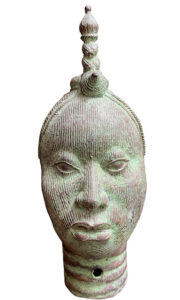
Benin bronze head from the Rootz Gallery Collection. Here you see the facial symmetry.
Restitution
Today, Benin bronzes are often cited in discussions of looted art. The original bronzes were looted by British settlers in the late 19th century from what was then the Kingdom of Benin (Southern part of present-day Nigeria). They ended up in museums and private collections around the world, but most of the statues ended up at the British Museum in London.
Nigeria has been trying to get the statues back for decades, and even has plans for a museum to properly care for and display the statues (called Museum of West African Art (MOWAA) in Benin City). However, their request has not had much effect yet. The problem with this type of application is that laws about it vary from country to country and there is no central, international legislation about it.[1]
Rootz Gallery Collection
The Benin bronzes sold by Rootz Gallery are not the original Benin bronzes. A long tradition has developed in present-day Nigeria and other parts of West Africa in which artists or artisans create replicas of the original masterpieces. We have some beautiful specimens in the store, but they are therefore not the looted ones.
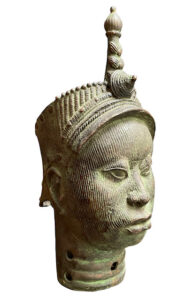
Benin bronze head from the Rootz Gallery Collection.

Another Benin bronze head from the Rootz Gallery Collection. Notice the difference in the form of the top of the head compared to the other one.
All in all, the Benin bronzes not only reflect the artistic sophistication of the kingdom, but also offer valuable insights into the social, political and religious aspects of society.
[1] Lecture by Evelien Campfens (lawyer specializing in international cultural and heritage law), Leiden University.
